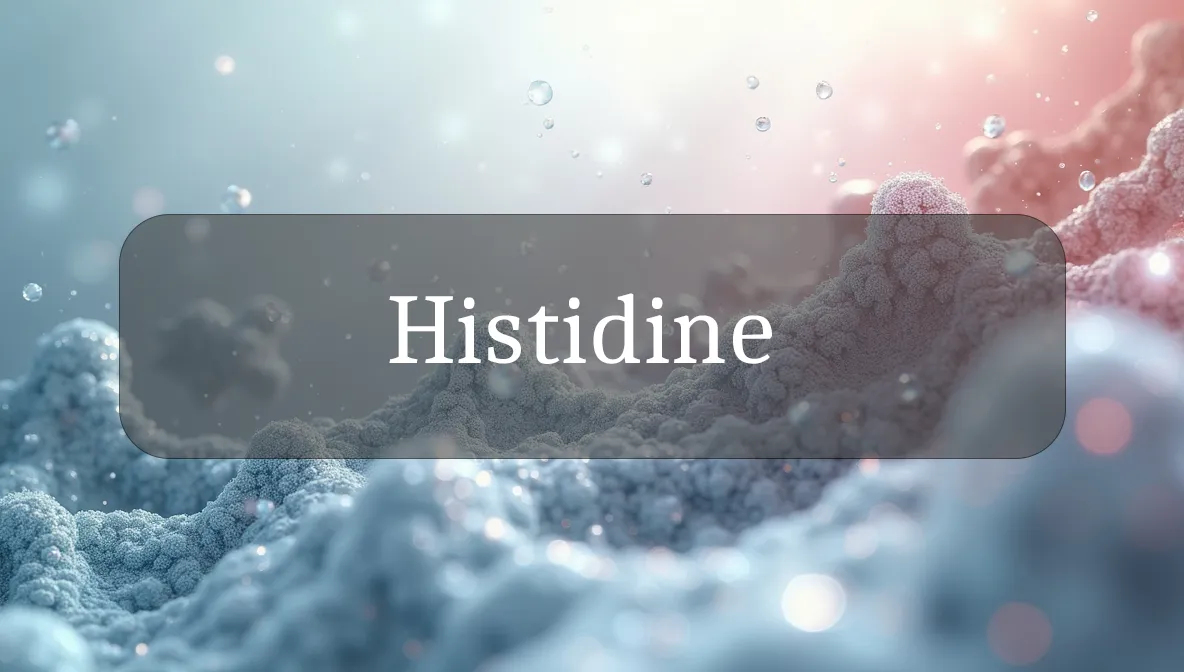Amino Acid for Growth and Immune Health
Histidine might not be a term you hear every day, but it’s a vital amino acid that acts like a versatile helper in your body, supporting growth, boosting immunity, and keeping your skin and joints healthy. Found in foods like fish, chicken, and beans, histidine is a key player in daily wellness, especially for those seeking energy, resilience, and overall vitality. Let’s dive into what histidine is, why it matters, and how to harness it for a healthier you, all in a friendly, easy-to-understand way.
Identity and Type
Histidine, also known as L-histidine, is an essential amino acid for children and a semi-essential amino acid for adults, meaning kids must get it from food, while adults can produce some but may need dietary sources during stress or illness. It’s a building block for proteins and a precursor to histamine, a molecule involved in immunity and digestion. Histidine is found in tissues and blood, supporting growth and repair. Think of it as a nutrient that fuels development and keeps your defenses strong.
Biological Role and Health Benefits
Histidine is like a multitasking champion, supporting key functions:
- Immune Support: Histidine forms histamine, which helps your immune system fight allergens and infections, acting as a cell protector to keep you resilient.
- Growth and Repair: It’s critical for tissue growth, supporting muscle, skin, and joint health, especially in children, athletes, or during recovery.
- Brain Health: Histamine from histidine acts as a neurotransmitter, aiding focus, alertness, and mood balance, promoting mental clarity.
- Digestive Health: Histamine stimulates stomach acid production, aiding digestion and nutrient absorption, supporting a healthy gut.
- Antioxidant Defense: Histidine binds to metals like copper, reducing oxidative stress and protecting cells from damage, boosting longevity.
By supporting immunity, growth, and digestion, histidine enhances overall wellness.
Dietary Sources and Supplements
Histidine is found in protein-rich foods and available in some supplements:
- Dietary Sources:
- Meats and Seafood: Chicken, turkey, beef, and fish (e.g., tuna, salmon; 3 oz tuna = ~800 mg histidine).
- Dairy: Cheese, milk, and yogurt.
- Plant-Based: Beans (e.g., soybeans, chickpeas), lentils, quinoa, and peanuts.
- Other: Eggs, whole grains (e.g., wheat, rice), and pumpkin seeds.
- Supplements:
- L-histidine capsules or powders (500–2,000 mg per serving), often used for immune or joint support.
- Found in amino acid blends, protein powders, or medical formulas.
- Body Production: Adults synthesize histidine from other amino acids in small amounts, but dietary sources are crucial during growth, stress, or illness.
- Environmental Sources: Histidine is in the food chain through plants and animals, with diet as the primary source.
A balanced, protein-rich diet typically provides enough histidine for most adults.
Signs of Imbalance
Histidine imbalances, usually deficiency, can affect immunity and growth, while excess is rare:
- Low Histidine:
- Symptoms: Fatigue, weak immunity, slow wound healing, or joint pain. May include poor focus or digestive issues in children or stressed adults.
- Causes: Low protein intake, malnutrition, chronic illness (e.g., kidney disease), or high demand (e.g., growth, injury).
- Impact: Can impair histamine production, tissue repair, or digestion, reducing resilience.
- Excess Histidine:
- Symptoms: Rare, but high supplemental doses may cause headaches, nausea, or allergic-like symptoms (e.g., itching) from excess histamine.
- Causes: Overuse of histidine supplements (>4,000 mg daily) or rare metabolic disorders (e.g., histidinemia).
- Impact: May overstimulate histamine receptors, causing discomfort or stress kidneys.
If you notice frequent infections, slow healing, or digestive issues, consult a doctor to assess histidine status.
Supporting Optimal Levels or Function
Ensuring healthy histidine levels is easy with these tips:
- Eat Protein-Rich Foods: Include 3–4 oz lean meats (e.g., chicken, tuna) or 1 cup beans daily for ~600–1,000 mg histidine. Add eggs or quinoa for variety.
- Balance Protein Intake: Aim for 0.8–1.2 g protein per kg body weight daily (e.g., ~56–84 g for a 70 kg person) to support histidine and other amino acids. Mix animal and plant sources.
- Supplement if Needed: Take 500–1,500 mg L-histidine daily with meals for immune or joint support, starting low to avoid side effects. Consult a doctor for long-term use.
- Support Histamine Balance: Eat vitamin C-rich foods (oranges, bell peppers) to regulate histamine levels and zinc-rich foods (oysters, seeds) to aid protein synthesis.
- Healthy Lifestyle: Exercise 30 minutes daily (e.g., walking, strength training) to boost tissue repair and immunity. Get 7–8 hours of sleep to support growth and recovery.
Blood tests for amino acid profiles or histamine levels can assess histidine status if needed.
Safety, Interactions, and Precautions
Histidine is safe in dietary amounts, but supplements require caution:
- Safety: Dietary histidine from foods is safe for most. High-dose supplements (>4,000 mg daily) may cause nausea, headaches, or histamine-related symptoms (e.g., itching).
- Interactions: Histidine supplements may interact with antihistamines or medications affecting histamine (e.g., for allergies), altering effects. Consult a doctor if on these.
- Precautions:
- People with kidney or liver disease should avoid histidine supplements, as they may stress metabolism.
- Those with allergies or histamine intolerance should monitor for reactions, as histidine boosts histamine production.
- Avoid high doses in pregnancy or breastfeeding unless guided by a doctor.
- Storage: Store protein-rich foods (e.g., meats, dairy) in the fridge or freezer. Keep histidine supplements in a cool, dry place, sealed tightly.
Fun Fact
Did you know histidine is the reason you sneeze when allergies hit? It turns into histamine, your body’s alarm system, rallying your immune system to tackle invaders like pollen or dust!
Citations
- National Institutes of Health (NIH). (2023). Amino Acids and Health.
- Mayo Clinic. (2024). Protein and Amino Acids: Overview.
- Cleveland Clinic. (2023). Amino Acids and Immune Health.
- World Health Organization (WHO). (2022). Protein and Amino Acid Requirements in Human Nutrition.
- USDA National Nutrient Database. (2023). Amino Acid Content in Foods.

